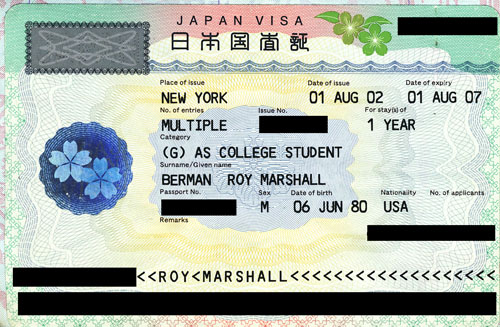
This is the first visa in my passport, the student visa from when I studied abroad at Ritsumeikan University in Kyoto, Japan in 2002. Note that although it is a multiple entry vis, in Japan one still must obtain a re-entry permit sticker at the local immigration bureau to be placed in one’s passport before leaving the country, or the visa becomes invalid. Naturally, this is an extra fee.

This is my first tourist visa for the People’s Republic of China. Note that unlike the Japanese visa, it actually uses Chinese characters the fill out some of the fields, most notably the “Issued at” field, which is marked “Osaka.” In fact, I applied for this visa at a very strange “travel agency” office around the corner from the Japan immigration bureau in Kyoto, which in addition to accepting applications for visas to China also serves the role of selling the payment stamps which one must use to pay fees at the Japan immigration bureau in lieu of actual cash when paying for such things as reentry permits or visa extensions.
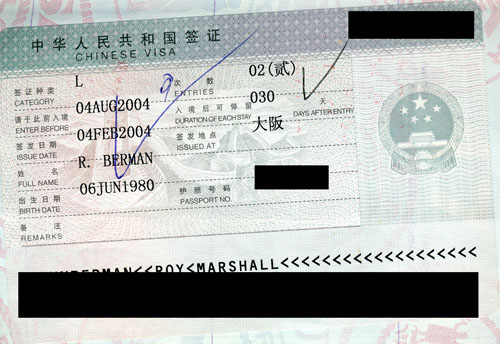
The only differences from the first one is that A: this one is double entry, so I could reenter China after my bus trip to Kazakhstan from Urumqi, and that it was glued to my passport in an extremely crooked fashion.
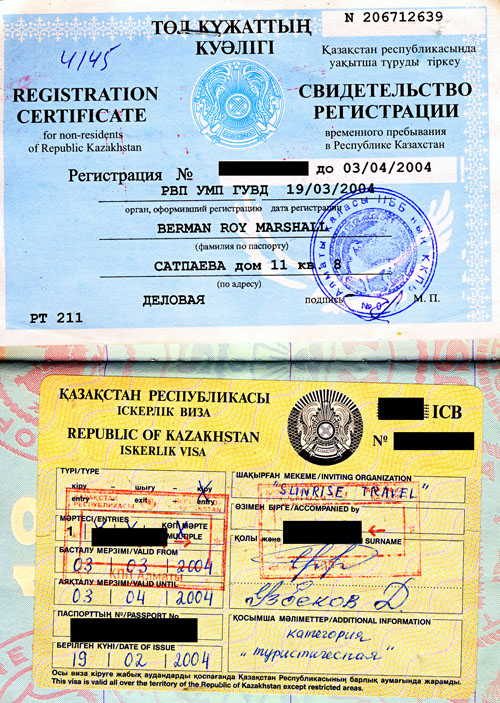
This is actually two separate, but related documents. The yellow thing is my tourist visa for Kazakhstan, and the blue thing above it is the “Registration Certificate” that non residents are required to keep in their passports until they leave the country. Notice that the visa is glues, and the certificate is stapled so it can be removed. It is, however, too cool to remove. The Kazakh visa is notable for a couple of things. First of all, it is handwritten-the only 21st century visa I have ever seen which is. Secondly, the “Inviting Organization” of “Sunrise Travel.” One cannot just apply for a Kazakh tourist visa like with most countries-instead you must have a letter of “invitation.” Tourist agencies, such as Sunrise Travel, will provide these letters for a small fee-I believe it was on the order of US $20.
There is an item I wish I could place right next to mine, and there is a story to it. My traveling companion on this particular trip was “Saru”, formerly also a contributor to this site. For some reason instead of indicating a one month span as I did on my visa application, he listed the exact seven-day period we had been planning to be there. Unfortunately, he got the range slightly off, so that if we had actually left on the date indicated on his passport we would just barely miss the local celebration of Nauryz-the biggest public holiday of the year! Obviously, this would have been extremely undesirable, so on the day after we arrived in Almaty, our local friends with whom we were staying took us to the office of this Sunrise Travel who had “invited” us to the country and asked how to resolve it.
Saru asked, “what happen if I overstay my visa?”
In reply, the tall, somewhat manly Russian woman with coarse black hair and a gigantic mole on her nose laughed heartily saying, “you go to jail!”
In the end, for a moderate fee she managed to work something out for Saru, but it was a rather odd solution. Instead of an extension to his tourist visa, or even a new tourist visa, she got him a business visa, which kicked in the day after the tourist visa ended. A one-day business visa. It looks much like the tourist visa, except for being blue, but I imagine that a single day business visa for Kazakhstan must be very nearly unique in the history of travel.
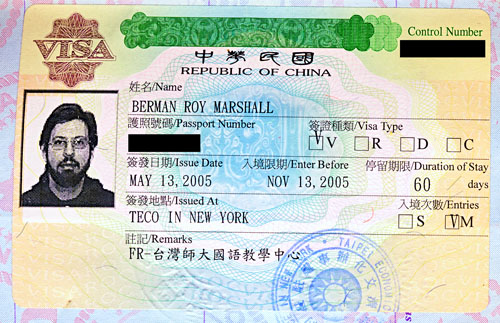
This is my “Visitor Visa” for Taiwan (legal name, “Republic of China”). I went there to study Mandarin in Taipei immediately following my undergraduate graduation from Rutgers University on a Taiwan government Summer term scholarship for Mandarin study, originally planning only to stay for the three-month Summer term. You may notice that the Duration of Stay is only 60 days. This is because a Visitor Visa has a term of only 60 days, which may be extended twice, for a total stay of 180 days. Why was I on a Visitor Visa instead of a Student Visa? Due to a very peculiar visa system, Taiwan does not actually HAVE such a thing as a Student Visa-only Visitor and Resident. Although a full time university student from abroad would qualify for a Resident Visa, since ordinary Chinese language schools there only enroll on a quarterly basis, language students are issued Visitor Visas. But what if you want to stay and study for longer than 180 days? The answer is below.

This is my Resident Visa for The Republic of China (Taiwan). After studying in Taiwan on a Visitor Visa for four months, one is eligible to apply for a Resident Visa. Once you have a Resident Visa, you are then eligible to apply for the ARC (Alien Registration Card) and upon having that, to the national health system (which incidentally works very much like the one in Japan).
The entire system is absurdly cumbersome, with Visitor Visa extensions and ARC applications being handled by an office of the county or city police, but the Resident Visa application being handled by the immigration department, in an entirely different part of the city (at least in the case of Taipei). Visitor visa extensions for language study also require the submission of an attendance tracking form, which one obtains from the administrative office of the language school. If a student has more than a couple of absences, they may then be subject to questioning and browbeating by a member of the foreigner registration section of the Taiwan police.
All in all, it is extremely bureaucratic, containing a number of overly complex and supervisory elements which I suspect (but do not know) are based in the former police state period of Chiang Kai Shek’s regime.

After leaving Taiwan, I got a job working in the office of the College of Information Science and Engineering at Ritsumeikan University’s Biwako Kusatsu Campus, near Kyoto. Although the contract was technically only for one year, it was of a type commonly renewed twice, which I suppose explains why I was granted a 3-year visa.
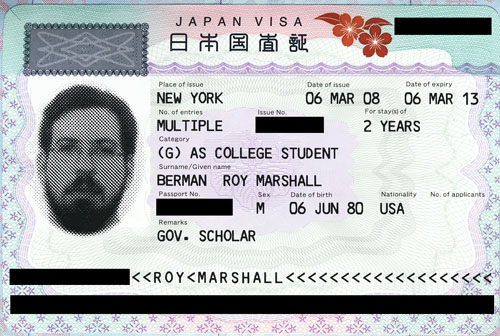
This is the one I got yesterday.
